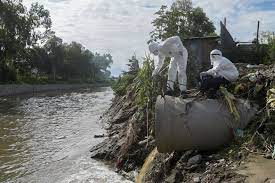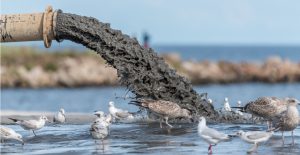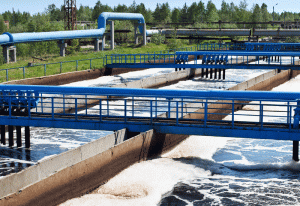Sewerage and Carcinogenic Coastal Waste
An array of barriers, cultural and religious negatively impact on wastewater and sewage treatment. Many are squeamish at the thought of using sewage treated water. One must realize that dumping sewage and wastewater into drains, rivers and sea is harmful to the environment, contains carcinogenic elements, drives away marine and coastal tourism, causes stench , destroys fish and marine life and aquatic habitats and ecosystems. Hulls of boat and ships are corroded as well.Diseases thrive in sewage. Turkey has the longest Mediterranean coastline of 8,333 kilometres of which 1,067 kilometres are island shores of the Sea of Mediterranean (including the Aegean Sea). Pollution in Turkey can extend to the inland Sea of Marmara and the Black Sea .A decade ago nearly 80 to 90 % of waste water and sewage of municipalities remained untreated. Today Turkey has 1,015 domestic wastewater treatment plants ,either in operation or under construction, and 10.5 million m3 wastewater is treated daily. The proportion of treated wastewater generated by municipalities in the year 2016 was around 82 %. In 2018 the treated wastewater was 85 % and by the year 2023 municipality wastewater treatment is expected to attain 100%.
 Credit Scientific American
Credit Scientific American
Over 2 billion tons of waste are produced annually across the world destined to 48,000 primitive landfills which release methane , a toxic and at times lethal gas . In Pakistan these dumping sites are located in the outskirts of Lahore and Karachi both provincial capitols, polluting the environment with plastic waste . Cities drown in their waste and sewage which spread diseases rapidly amongst all financial strata of society . The open burning of waste from these primitive landfills results in severe air pollution responsible for almost 2 million deaths in India . In countries like the United Arab Emirates and Monaco , which are tourist destinations, such primitive landfills are converted to waste to energy power plants also serving the purpose of controlling of litter. Globally the number of waste-to-energy plants operating worldwide exceeds 2,700 . The waste to energy plants number 500 in Europe, over 900 in China and around 300 in Japan and is the main reason why their cities are considered clean.
Diametrically Opposite Coastal City
Karachi is Pakistan’s major coastal and industrial city with a huge population of more then 20 million .The city generates almost 472 million gallons (MGD) of sewage and waste water and it is astonishing to note that only 10 % is treated. Waste water from Karachi’s 8 industrial areas is untreated despite regulations requiring treatment of factory effluents. There is a Combined Effluent Treatment Plant installed at Korangi Industrial Area, capable of treating wastewater generated from 150 tanneries which dump heavy metals and their compounds and toxic chemicals into the Korangi Creek. It operates on Anaerobic Sludge Blanket technology and was built when exports dropped.
Along Karchi’s coast sewage gushes out of pipes into rivers and the sea, threatening the health of humans and aquatic ecosystems. Sewage contains fecal pathogens and nitrogen which cause harmful algae blooms and marine dead zones or oxygen deprived zones. Waste water flows from the Malir River, drains and the Lyari river into the harbor and sea. The city has 3 water treatment plants (TP) which have a designed capacity to treat only 150 MGD. Two of the three TP’s are operational namely the Gutter Baghicha TP and Mauripur TP. The Mehmoodabad TP mysteriously remains inoperational. The Gutter Baghicha TP is reflected in Karachi municipality legends as once comprising of over 1,016 kms and encroachment with connivance of land mafias has wrecked havoc with the sewerage and waste water treatment mechanism. The Gutter Baghicha TP was set up at the onset of colonial rule.
 Credit Natural History Museum
Credit Natural History Museum
SDG and Oceans
Sustainable Development Goal 14 concerns Life Below Water and is an integral aspect of the 2030 Agenda for Sustainable Development.The UN Ocean Conference 2022 calls for a sustainably managed ocean involving green technology and innovative use of marine resources using an integrated and ecosystem based approach. The UN Conference 2022 identified climate change, uneducated reclamation, non adherence to internal pollution control laws and charters, mangrove and coral reefs destruction, marine pollution, unsustainable fishing, invasive species and the loss of marine habitats and biodiversity as significant threats to sustainable exploitation of ocean resources.
Financing by Regional Countries
 Credit MEP Middle East
Credit MEP Middle East
Bahrain plans to expand its wastewater treatment capacity and is constructing an additional wastewater treatment plant estimated to cost $ 460 million . Almost US $ 10 billion has been made available by the Emirate of Abu Dhabi , primarily to protect and preserve its own coastline and to quell protests in the wake of the “Arab Spring” . The choice of treatment may vary between septic plants which contain the nitrogen or waste water treatment which filter fecal pathogens.
By Nadir Mumtaz

Leave A Comment